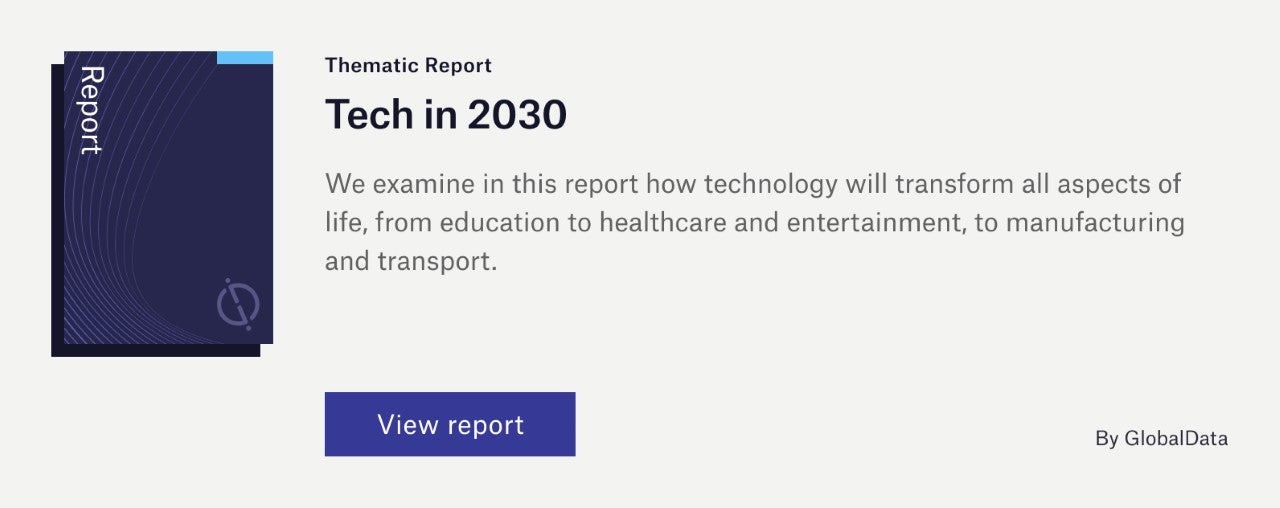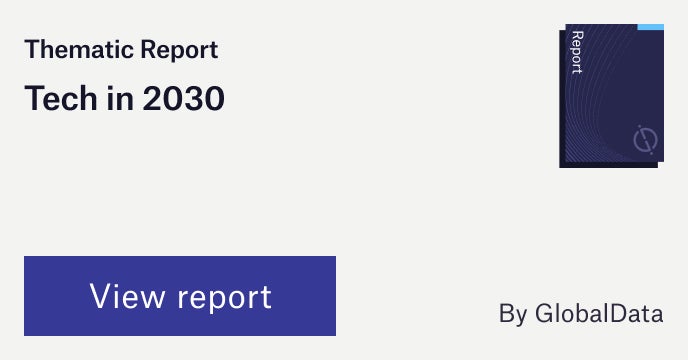The future of the mining industry will be shaped by a range of disruptive themes, with Internet of Things (IoT) being one of the themes that will have a significant impact on mining companies. A detailed analysis of the theme, insights into the leading companies, and their thematic and valuation scorecards are included in GlobalData’s thematic research report, Internet of Things (IoT) in Mining – Thematic Research. Buy the report here.
In an industry known for its complex and hazardous operations, IoT solutions enable mining companies to automate workflows, improve efficiency while reducing costs, and improve safety and environmental, social, and governance (ESG) credentials across the whole value chain. IoT supports mining operations such as autonomous drilling, driverless haul trucks, health and safety monitoring, energy management, and environmental monitoring. IoT technologies enabling these mining operations include drones, wearable tech, proximity detection sensors, and autonomous trucks. Also, a growing number of products and services incorporate AI into their capabilities, especially for predictive maintenance and digital twin modeling.
However, not all companies are equal when it comes to their capabilities and investments in the key themes that matter most to their industry. Understanding how companies are positioned and ranked in the most important themes can be a key leading indicator of their future earnings potential and relative competitive position.
According to GlobalData’s report, Internet of Things in Mining leading adopters of IoT include Anglo American, BHP, Fortescue Metals, Rio Tinto, Vale.
Insights from top ranked companies
BHP
BHP has deployed autonomous trucks in various mines since 2017. In 2020, BHP introduced the Dynamics 365 Remote Assist Dash Maintainer Tools to help equipment staff gather key information and data remotely, keeping workers safe during COVID-19. The tools use IoT sensors on machinery and Microsoft Azure cloud services. Also, the company uses cloud services and a mixed-reality headset device to assist auto electricians and mechanical fitters on-site. The company has also invested in special caps to log drivers’ brainwaves to monitor signs of them falling asleep at the wheel thanks to sensors put in a six-inch strip that is fitted inside the helmets of employees. In 2022, BHP inaugurated its first autonomous drill at the Chilean Spence mine.
Rio Tinto
Rio Tinto made steps into predictive maintenance in 2015 with its analytics excellence center in Pune, India. It assesses data captured by the array of sensors attached to Rio Tinto’s fixed and mobile equipment to predict and prevent engine breakdowns and other downtime events. Rio Tinto’s mine automation system (MAS) pulls together data from 98% of the company’s mine sites into a common data format, which can be displayed visually in Rio Tinto Visualisation (RTVis). The platform integrates data collected from autonomous equipment from different manufacturers. In July 2021, the company announced that it would deploy the world’s first fully autonomous water trucks at its Gudai-Darri iron ore mine in Western Australia, developed in collaboration with Caterpillar. The dust suppression vehicles will track water consumption digitally and reduce waste. A year after the company officially opened the mine, it was named Rio Tinto’s most technologically advanced iron ore mine in the Pilbara region. It features autonomous trucks, trains, drills, and water carts, a full digital replica, and varied robotic solutions. In 2023, the mining company continues to invest in developments to its autonomous haul trucks, partnering with Scania, Wenco, and Caterpillar to optimize open pit operations with the Cat MineStar Fleet management system at the Bingham Canyon Mine.
Vale
Vale began implementing a digital transformation strategy in 2016 to adapt itself to Industry 4.0, incorporating IoT as one of the technologies. In 2019, it signed an agreement with Vivo to implement a private 4G-LTE network in Brazil, investing almost BRL21 million ($3.7 million). The company uses autonomous haul trucks at its operations in Carajás and Brucutu mines in Brazil. Vale uses drones to monitor wagons carrying ore to improve efficiency and for enhanced safety at Tubarão railroad yard, Espírito Santo, Brazil. Autonomous excavators have been implemented at its Totten mine, Canada, which can be remotely controlled. Vale uses IoT solutions for various purposes, such as vibration monitoring, rollers and conveyor belts, and geotechnical instrumentation. In 2022, Vale reached 72 pieces of autonomous equipment in operation across four Brazilian states. In 2023, the company approved the SpectraFlow Crossbelt Analyzer for online measurement of iron ore material at its ports and mines.
Access GlobalData’s latest thematic research report on the Internet of Things in Mining to further understand the key themes and technologies disrupting the mining industry. The mining companies featured in our thematic scorecard are listed below.
- Polyus
- Kirkland Lake gold
- Barrick Gold
- Polymetal International
- Kinross Gold
- Northern Star
- Zijin Mining
- Impala Platinum
- AngloGold Ashanti
- China Molybdenum
- Sumitomo Metal Mining
- Agnico-Eagle Mines
- Glencore
- POSCO
- Sibanye-Stillwater
- Freeport-McMoRan
- ArcelorMittal
- Shandong Gold Mining
- Nornickel
- Tata Steel
- Saudi Arabian Mining
- Severstal
- Jiangxi Copper
- Antofagasta
- Vedanta
- Nippon Steel
- First Quantum Minerals
- Hindalco Industries
- South32
- Evraz
Data Insights
From

The gold standard of business intelligence.
Blending expert knowledge with cutting-edge technology, GlobalData’s unrivalled proprietary data will enable you to decode what’s happening in your market. You can make better informed decisions and gain a future-proof advantage over your competitors.
Frequently asked questions
-
1. How are Mining companies using Internet of Things (IoT) technologies?
Mining companies are using IoT technologies to increase efficiency, improve productivity, and reduce costs on mine sites. IoT devices such as drones, wearables, proximity detection sensors on moving machinery and vehicles, and scanners to identify different ore grades can all yield small but cumulative gains in productivity. IoT can also help improve health and safety by using wearable technology and proximity detectors.
-
2. How do internet of things (IoT) technologies impact the Mining industry?
IoT technologies are transforming the mining industry by enabling companies to monitor and account for different assets and people across vast distances in hazardous conditions. IoT can help mining companies improve their ESG credentials by monitoring their emissions and preparing for a carbon-neutral future. IoT can also help mining companies overcome key challenges such as reducing carbon emissions, improving productivity, and enhancing safety.
-
3. Who are the top adopters of internet of things (IoT) technologies in Mining?
The top adopters of IoT technologies in mining include Anglo American, AngloGold Ashanti, Barrick Gold, BHP, Freeport McMoRan, Fortescue Metals, Newmont, Teck Resources, and Vale.
-
4. Who are the leading vendors of internet of things (IoT) technologies to the Mining industry?
The leading vendors of IoT technologies to the mining industry include AMD, Intel, STMicro, Softbank (Arm), Apple, Bosch, Google, Analog Devices, Amazon, NXP, Nvidia, Qualcomm, Infineon, Samsung Electronics, Honeywell, Broadcom, Cisco, AT&T, Dell, NTT, Ericsson, Orange, HPE, SingTel, Huawei, Verizon, IBM, Vodafone, Telefonica, Juniper Networks, SAP, and Microsoft.
-
5. How do internet of things (IoT) technologies benefit Mining companies?
IoT technologies benefit mining companies by increasing efficiency, improving productivity, enhancing safety, and reducing costs on the mine site. IoT devices such as drones, wearables, proximity detection sensors, and scanners can all yield small but cumulative gains in productivity. IoT can also help mining companies improve their ESG credentials by monitoring their emissions and preparing for a carbon-neutral future.
-
6. What is the projected market size of internet of things (IoT) in Mining?
The projected market size of IoT in mining is expected to achieve a compound annual growth rate (CAGR) of 6.2% between 2020 and 2025.
-
7. Who are the leading specialist internet of things (IoT) vendors in Mining?
The leading specialist IoT vendors in Mining include ABB, Caterpillar, Emesent, Epiroc, Fatigue Science, Guardhat, Hexagon, Komatsu, Sandvik, SymboticWare, and Trimble.
-
8. What are the components of the internet of things (IoT) value chain?
The components of the IoT value chain include the device layer, connectivity layer, data layer, app layer, and services layer.





